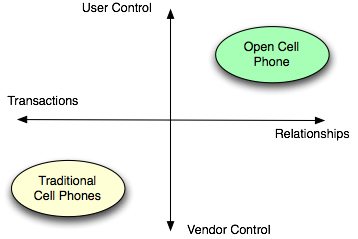White-box cell phones

At the Mobile Identity Workshop today Doc Searls led a discussion of white-box, or open phones. The problem is that, at least in the US, phones are tied to a particular carrier and have features crippled to force certain business models. Want to write software for the phone? You probably don't have access to all the features on the phone and you don't have access to the features of the network that links them. It's all closed.
That doesn't have to be the case. If you can come up with the right business model, the possibility exists to become a virtual carrier and be more open. Want an example? RaveWireless, a company that targets mobile phones in a university environment.
This diagram describes the difference in terms of two axes: one for control and one for interaction type.

On one end of the control axis is "vendor control" meaning that the vendor controls the experience. At the other is "user control" meaning that the user can control the experience.
At one end of the interaction axis is "transactions" meaning that the vendor just wants your money for service. At the other end, "relationships" means that the vendor interactions don't just exchange money for services but also establish community and social applications.
Christopher Carfi labels the upper left quadrant "the global village" and the lower-right quadrant "the matrix."
We've been stuck in the lower-left quadrant for so long, it's hard to imagine what other options would be like. To make this more concrete, consider the scenario where your phone and your friend's phones are linked into some kind of group. The movie's just let out, and you all agree to meet, and then advertise your intention to buy pizza to the shops in walking distance. Pier 49 sends back a response to your "micro-RFP" offering a table for nine in 15 minutes.
It's easy to see the relationships in this scenario. If you believe that one vendor could arrange this entire community, line up all the vendors, and control it all, then this could live in the lower-right quadrant, but experience (i.e. the Web) has shown that openness leads to much richer ecosystems than the alternatives (i.e. the old AOL).
Whether we can achieve this is held hostage to the closed mobile system that we live with. Is RaveWireless the answer? In an open scenario no single company can be the answer, but they are an example of the possibilities.